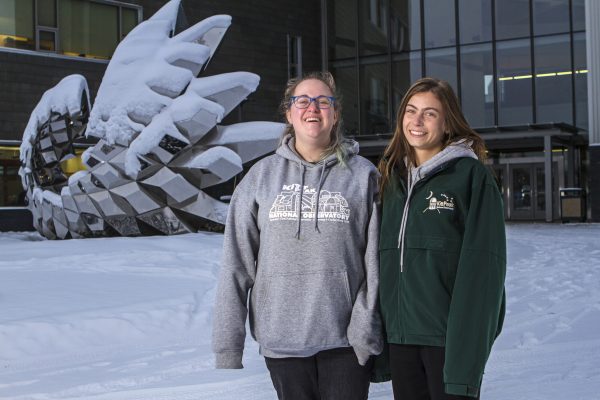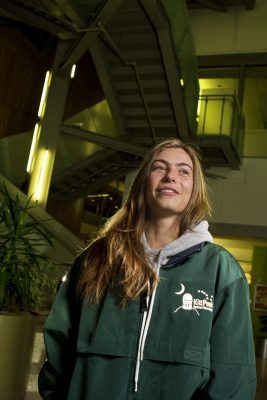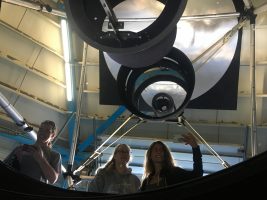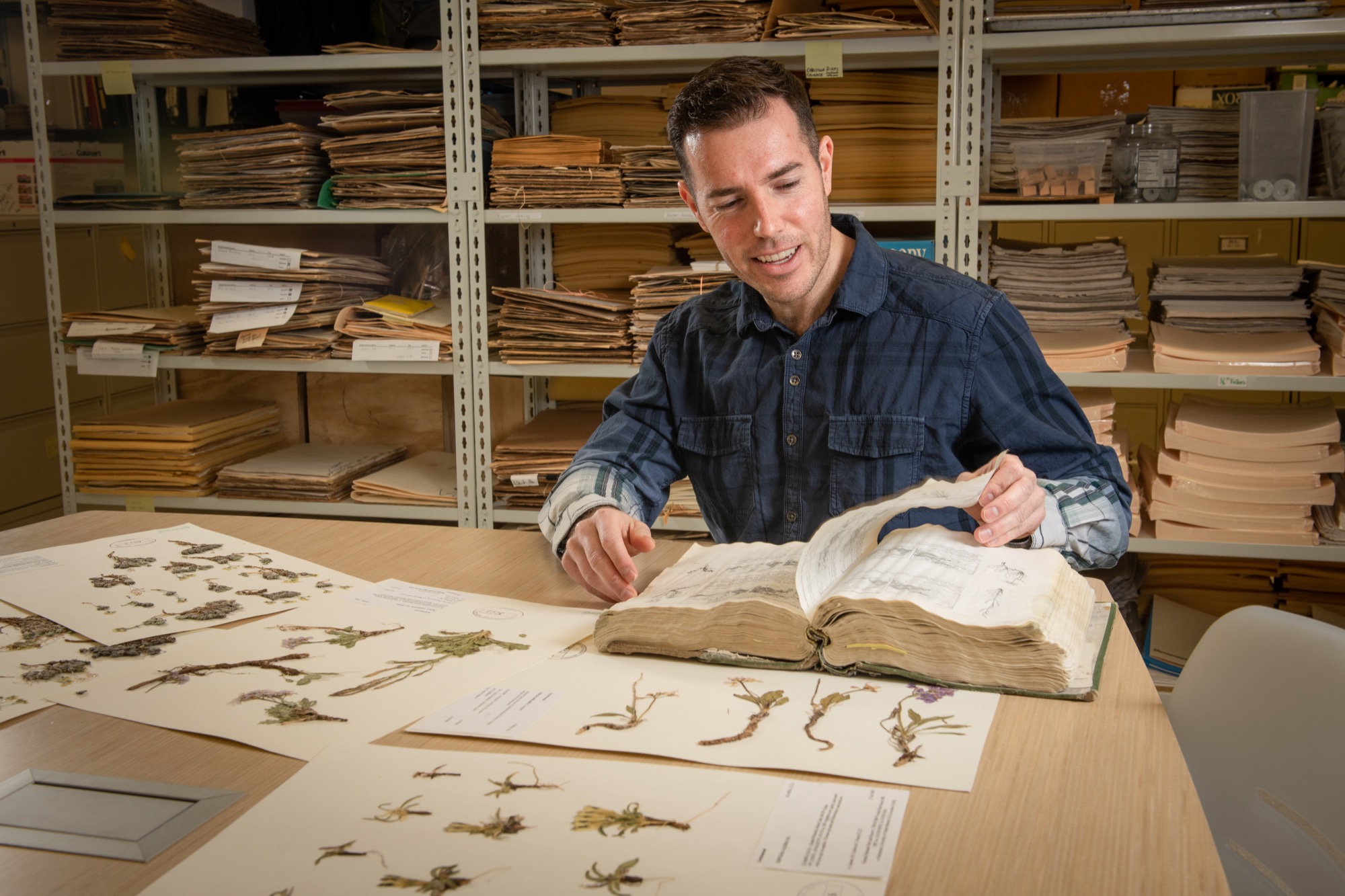The novae hunters
by cmmyers |
It's 4 a.m. in the dome of the .9 meter telescope at the Kitt Peak National Observatory (KPNO) 56 miles outside Tucson, Arizona, and Angela Cook, a UAA senior majoring in natural sciences and minoring in math and physics, pulls out her cellphone, snapping a couple of photos of classmate Hannah Crayton, a junior majoring in computer systems engineering and minoring in math and physics, who is curled up underneath a row of computers. Cook and Crayton started their "day" about 3 p.m. the afternoon before and have been up ever since, capturing images of the Andromeda Galaxy, also known as M31 - the galaxy closest to Earth's humble home in the Milky Way - in hopes of catching "super fast" novae.

From left to right, Angela Cook, a UAA senior majoring in natural sciences and minoring in math and physics, and Hannah Crayton, a UAA junior majoring in computer systems engineering and minoring in math and physics, after their return from the Kitt Peak National Observatory in Tucson, Arizona. (Photo by Brett Rawalt / University of Alaska Anchorage)
"Everybody knows what supernovae are - you know, they're huge, they're big explosions when stars are just too big and they collapse in on themselves - and it's beautiful," said Cook. "Those things can last for a really long time - like hundreds and thousands of years; we can still see the remnants of them. Super fast novae, a different type of phenomena that supernovas happen within a few hours, and then they're gone. That's what we were looking for."
The two were invited down by Dr. Travis Rector, a professor in UAA's Department of Physics and Astronomy. Rector has been studying novae behavior for more than 20 years and has been coming to KPNO to acquire images of the Andromeda Galaxy in hopes of capturing super fast novae in action.
Novae are explosions that occur on the surfaces of stars called "white dwarfs." This massive explosion doesn't destroy the white dwarf but blows elements like carbon, nitrogen and oxygen out into space, and these elements eventually become a part of new stars and planets when they form. According to Rector, about half of the carbon, nitrogen and oxygen in our bodies comes from novae. These explosions are therefore essential for the formation of life on planets.
"We are studying the Andromeda Galaxy because it is a nearby galaxy similar to our own," said Rector via email. He is currently on sabbatical for the 2018-19 academic year, working on a new telescope project - the Large Synoptic Survey Telescope (LSST), which is currently under construction in Chile, South America. "We want to know how many novae explode in this galaxy because it helps us to understand how many Earth-like planets may be out there."
The big picture
The catch? Actually capturing images of these massive explosions through the telescope is a bit of a needle-in-the-haystack type situation. They happen really fast and can explode and disappear within an hour.
"We took exposures of M-31 for a few minutes at a time, and then all those images get compiled together and we'll be able to go through them and see if there's a star that appears, but then is gone," said Cook, explaining that if they see a star that was there in one frame, but gone in the next, it is mostly likely a nova explosion. "This is really hard to do because something like a cloud could come between us, and that could've been the time that one of them happened, or like right after sunset or sunrise that's when it happened. So you have to be looking at the right place at the right time."
Needless to say, the pair didn't sleep a lot and both said the weeklong event was a bit of a blur, but completely worth it to experience research on a completely new level. Cook said it was kind of like summer camp because there were anywhere from 50 to 100 researchers from around the world there, squeezing in as much work as possible into their allotted time at KPNO. There wasn't a lot of time between research and their regular homework for classes at UAA, but the two were able to get out, take photos and explore some of the other telescopes.

Crayton has been working with Travis Rector, a professor in UAA's Department of Physics and Astronomy, for two years, helping analyze data of super novae in the Andromeda Galaxy. (Photo by Brett Rawalt / University of Alaska Anchorage)
Crayton has been working with Rector on this research for almost two years now, analyzing data from his past trips to KPNO. She was meant to go along last year but had scheduling conflicts, so when the opportunity came up again this year, she was determined to make it happen.
"It was really impactful for me personally because space has been my passion; it's what I'm trying to get to and what I've been working toward since the start," said Crayton. "I remember my dad had a telescope when I was younger and he'd bring me up to Flattop to teach me the constellations. So then having the opportunity to see those same stars up at KPNO was a neat representation of the progress I've made. It was a research trip, but it was also so much more than that for me."
Crayton said the trip also broadened her understanding of the day-to-day research she does at UAA with Rector. She was able to see the behind-the-scenes process of this huge research project and how her contributions fit into the overall grand scheme of things.
"So the big picture, the biggest picture of this very specific research project, is that it leads into us getting an idea of how often these novae are occurring, where they're occurring and how much material is being ejected," said Crayton.
She said if they can get an idea of how much material is being emitted into space during novae explosions than they can start calculating the likelihood of this material being located in other parts of the galaxy, which will get researchers one step closer to understanding the building blocks of life.
Get in focus
Cook's and Crayton's workday ended at about 5 a.m., and the two dragged themselves back to the dormitories to sleep. They set their alarms for about 3 p.m., have a couple of hours for dinner, gather everything they would need for the night and be on the road toward the telescope at about 5 p.m.
"The coolest thing about the .9 meter telescope is it's one of the last ones you still have to set up by hand," said Cook. "You actually have to go in and touch the telescope, whereas nowadays, a lot of the modern ones, you don't even have to go down there. Like the one Erin (Hicks) uses down on Mauna Kea; when she gets her time, she just logs into her computer from up here."
Cook and Crayton spent about an hour each day setting up the telescope, carefully going through their checklist from removing the telescope's lens protector, to turning on the fans and manually moving the telescope around from the computers inside the telescope's dome, making sure it would lock onto where they were pointing to capture images of the night sky.
"We were super careful with everything, because, you know if we messed something up, there goes that night," Cook said. She said she and Crayton even had to manually open the dome, an opening where the telescope looks out. "It was such a cool experience."
Once the telescope was positioned correctly, Cook and Crayton spent the remainder of the setup time making sure everything was in focus and ready to capture images. Cook said that was one of the most challenging steps in the process. She said she could never get it quite right, but Rector is a pro.
"Hannah and I would be working on it for half an hour and say, 'I think we got it,' and he would touch one thing and then it would be perfect," Cook said. "He told us not to feel bad; I think he said he's spent 400 nights down at Kitt Peak in his career. So he's an expert."
Once the telescope was in focus and it was confirmed it was pointing at M-31, the real work of capturing thousands of images began. It's a precise process that required taking both long and short exposures, and if anything was slightly off, there was potential to ruin an exposure.
Weather also plays an important role in being able to capture pictures of Andromeda. Cook and Crayton said that anything from clouds to rain could sabotage a night of research, and that at one point a thunderstorm came roaring through and Rector had to run an emergency shutdown of the telescope so all the equipment wouldn't get fried.
The great beyond
Although Rector's research is focused on a galaxy far, far away, the opportunity for Cook and Crayton have real-world implications. The two were able to step into the research role to see if this is something they want to pursue in their careers, or at the very least, an experience to add to their resumes.

A super selfie: (from left to right) Travis Rector, Angela Cook and Hannah Crayton take a minute to snap a photo in the lens of the 0.9 meter telescope at the Kitt Peak National Observatory. (Photo courtesy of Hannah Crayton)
Cook said she's not sure what she'll do once she graduates, but that her week at KPNO helped bridge the gap between the classroom and the real world.
"This experience gave me a concrete idea of what I could do for a career," said Cook.
For Crayton, she's still shooting for the stars and hoping that one day all of her undergraduate research, graduate school career and beyond will lead her to space, either through NASA or a private space exploration organization.
"That's what's cool about astronomy, said Crayton. "We don't know anything, comparatively - you can never stop discovering," said Crayton. "It's a domino effect; you figure one thing out and then you figure something else out. It's a constantly evolving field." "The novae hunters" is licensed under a Creative Commons Attribution-NonCommercial 4.0 International License.
"The novae hunters" is licensed under a Creative Commons Attribution-NonCommercial 4.0 International License.














